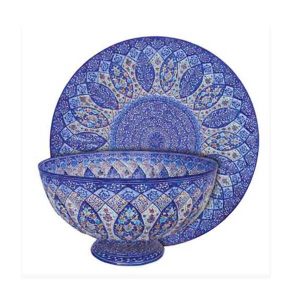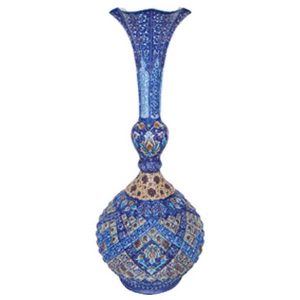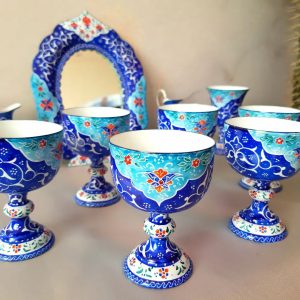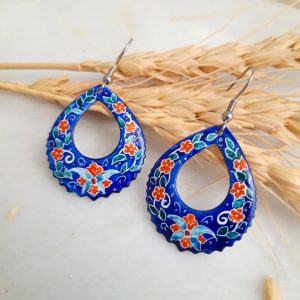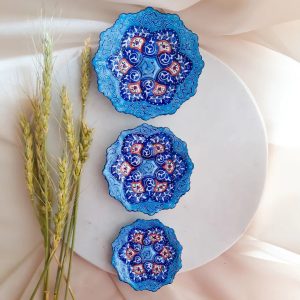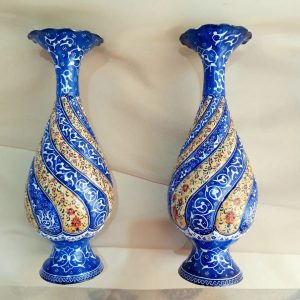Minakari Enamel Pottery
What is Minakari (Enamel Pottery)?
Minakari, commonly known as enamel pottery, is a centuries-old art form originating in the Isfahan region of Iran. This traditional art form involves hand-painting intricate designs and colorful enamels onto pottery and copper pieces. The enamels are fired and cooled to create a glassy, durable, vibrant surface.
Minakari, also known as Enamel Pottery, is a traditional Persian handicraft that involves the art of painting and decorating metal objects with vibrant enamel colors. It is a meticulous and intricate process that requires skilled craftsmanship and attention to detail. The technique involves fusing powdered glass onto a metal surface, typically copper, through firing processes.
Ersaly online shop offers a collection of authentic Persian Minakari artworks, allowing art enthusiasts and collectors to appreciate and acquire these exquisite pieces. With their commitment to preserving Persian handicrafts, Ersaly provides a platform to explore and purchase Minakari artworks created by talented artisans.
History of Enameling on Pottery
The history of enameling on pottery dates back centuries and is still practiced today. This traditional art form involves hand-applying colorful enamels to pottery and copper pieces to create unique and stunning art pieces. The enamels are fired and cooled to create a glassy, durable, and beautiful surface.
What is Persian Minakari Enamel Pottery?
Persian Minakari enamel pottery is a type of Persian art that involves inlaying various materials into metal. It is believed to have originated in the 15th century in Iran, where it is still practiced today. The practice has also spread to Central Asia, Turkey, and the Caucasus. The inlaid materials used in Minakari enamel pottery include silver, gold, copper, brass, tin, stones, glass, and other items.
Origins of Minakari Enamel Pottery
The origins of Minakari enamel pottery can be traced back to the 15th century in Persia. It is believed that the Ottoman Empire first developed the art form and then spread to Central Asia, Turkey, and the Caucasus. Since then, it has been an essential part of Persian culture and is still practiced today.
The Process of Creating Minakari Enamel Pottery
Creating Minakari enamel pottery requires great skill, involving inlaying various materials into metal. A unique tool is needed to cut the metal into the desired shapes before adding the inlaid materials. The metal is heated in a kiln once the inlaid pieces have been added. This process gives the metal its unique and intricate design.
Different Types of Minakari Enamel Pottery
There are a few different types of Minakari enamel pottery, including earthenware, porcelain, and stoneware. Each type has its unique characteristics and can be used to create various designs.
The Color Range of Minakari Enamel Pottery
Minakari enamel pottery can be made in various colors, from traditional blue and green colors to more vibrant reds and yellows. Depending on the type of metal used and the inlaid materials’ colors, the pottery colors can vary greatly.
Design and Motifs of Minakari Enamel Pottery
Minakari enamel pottery is characterized by its intricate and detailed designs. These designs often feature Persian and Islamic motifs, such as flowers, birds, and geometric shapes. These motifs can be seen in both the inlaid materials and the metal itself.
Care and Maintenance of Minakari Enamel Pottery
Minakari enamel pottery is a delicate art form and should be handled carefully and respectfully. To ensure the longevity of the pottery, it should be kept away from direct sunlight and moisture, as this can cause discoloration and corrosion. It should also be dusted regularly and wiped with a dry cloth to keep it clean. It is important not to use harsh chemicals or abrasive materials when cleaning Persian pottery, as this can damage the design.
Notable Examples of Minakari Enamel Pottery
There are many notable examples of Minakari enamel pottery. One of the most iconic pieces is the Blue Mosque Candlestick, a beautiful example of the art form. Other famous pieces include the Jug of Sultan Ahmad from the 16th century and the four-legged vase from the 18th century.
Famous Artisans of Enamel Pottery
Throughout the centuries, many famous artisans have worked in the field of Minakari enamel pottery. Notable figures include Ali Beyk, a master craftsman from the 19th century, and Gholam-Hossein Amirkhani, a contemporary artist. These artisans have created some of the art form’s most iconic and intricate pieces.
Where to Buy Minakari Enamel Pottery
“Minakari Enamel Pottery” is an exquisite traditional craft in many places in Iran and throughout the Middle East. It is handcrafted pottery decorated with intricate designs of colorful enamel. You can find an array of Minakari Enamel Pottery at our online shop. Our collection includes various items such as plates, bowls, and vases in different sizes and colors.
Our products are of excellent quality and designed to last a lifetime. So if you’re looking for a unique and beautiful piece of pottery, shop at our online store today.
Minakari Vase, Plate, Pitcher, Tea Set, Candy Bowl
Minakari Vases, Plates, pitchers, Tea Sets, and Candy bowls are all classic pieces of Minakari art. Each piece is handcrafted with intricate designs and vibrant colors, making them perfect for any home or collection. The pitcher and tea set are top-rated because of their unique shapes and colors.
Handcrafted Minakari Enamel Pottery
Handcrafted Minakari Enamel Pottery is a timeless treasure that adds beauty and elegance to any home. Each piece is a work of art with intricate designs and colorful enamels. This traditional art form originates in the ancient Persian Empire and perfectly expresses your love for art and culture.
Minakari Enamel Pottery Art in Isfahan
Minakari art is also popular in Isfahan, Iran, and has been a part of the city’s culture for centuries. The art of Minakari is still practiced in Isfahan today, with traditional workshops and stores selling pieces of this exquisite art form.
Minakari vase
A Minakari vase is an ideal way to add a touch of elegance to any room. These handcrafted pieces come in various shapes, sizes, and designs, making them perfect for home decor.
Minakari plate
A Minakari plate is a great way to add a statement piece to any room. These beautifully handcrafted plates come in various styles and can be used as a centerpiece or accentuate shelves and tables.
Minakari design
Minakari designs are intricate and vibrant, making them perfect for any home or collection. With its captivating designs and exquisite colors, each Minakari art is truly a work of art.
Minakari set
Minakari sets are great for those looking to make a statement in their home. A set of handcrafted Minakari pieces is the perfect way to bring a touch of sophistication and elegance to any room.
Enamel on pottery
Enamel on pottery is a traditional art form that has been practiced for centuries. It involves using colorful enamels to handcraft intricate designs on pottery pieces.
Enamel on pottery and copper
Enamel on pottery and copper is a unique art form that is beautiful and durable. The process involves carefully applying colors and designs to copper and pottery pieces for a vibrant and timeless look.
FAQs:
What is Minakari?
Minakari is an ancient art form originating in the Rajasthan region of India. It involves hand-painting intricate designs and colorful enamels onto pottery and copper pieces. The enamels are fired and cooled to create a glassy, durable, vibrant surface.
What types of pieces can you make with Minakari?
Minakari pieces come in various shapes, styles, and sizes, making them perfect for any home. Popular pieces include vases, plates, pitchers, tea sets, and candy bowls.
Is Minakari durable?
Minakari pieces are highly durable due to the firing process. This means they can be enjoyed for many years to come.
What is the origin of Minakari?
Minakari originated in the Rajasthan region of India and has been practiced for centuries.
Is Minakari a traditional art form?
Yes, Minakari is a traditional art form that has been practiced for centuries and is still practiced today.




